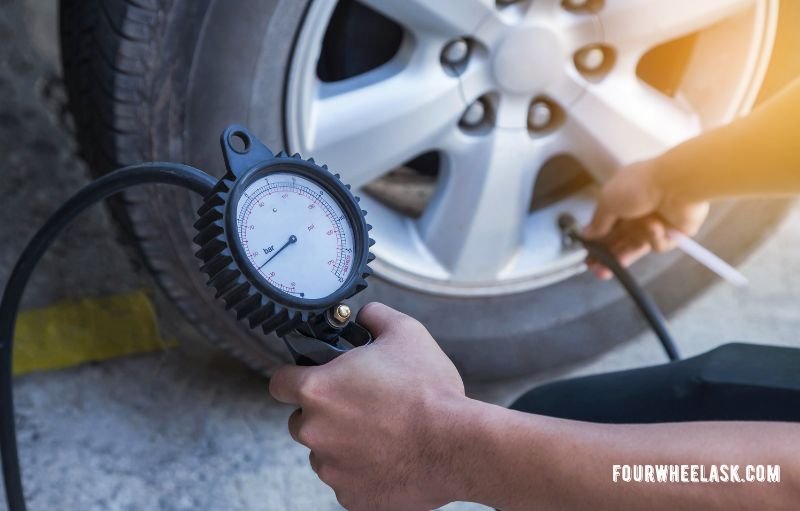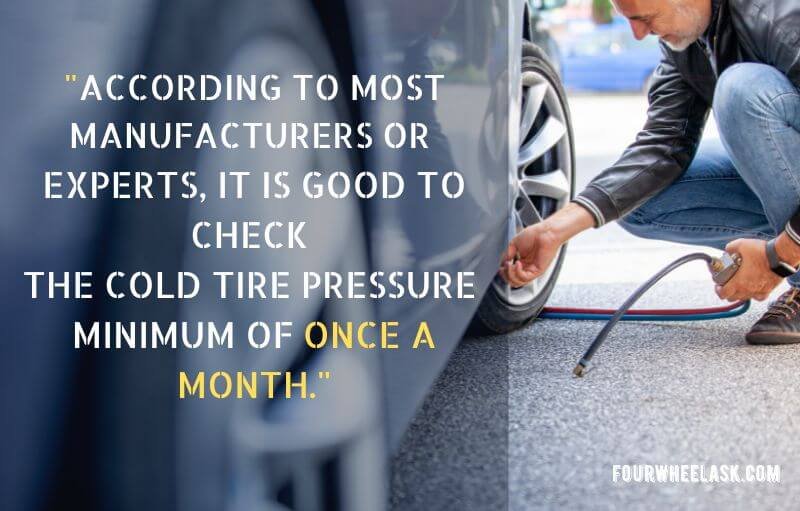What Does Cold Tire Pressure Mean and how to Check?
Tire pressure varies depending on the wheels surrounding temperature. While taking care of your tire air pressure, – you must’ve learned ‘cold tire pressure’ and wondered what it means.
Cold tire pressure refers to the pressure of tires at ambient temperature. Typically, before driving or after the vehicle has been parked for a while. It’s vital because tire pressure directly affects handling, braking, and overall tire lifespan. Also, maintaining the correct cold tire pressure is crucial for your safety on the road.
I briefly discussed what does cold tire pressure mean in this guide. Also, you will learn how to check and how often to monitor the cold tire pressure. Let’s get going.

cold tire pressure meaning
Cold tire pressure means that your car tires have had enough time to cool down after a long drive and reach their ambient temperature.
Car tires are made of rubber. When we drive our car, flexion of the rubberized tires constantly happens because of the road heat. Although tires are circular, the flatter parts of the tire at the bottom create friction due to continuous flexing. However, the natural circular shape retains immediately as the tire rotates.
For shorter-distance driving, the accumulation of heat because of friction is minimal. On the other hand, heat is stored in the wheels for longer-distance driving. Moreover, faster driving creates more friction when you drive for a short distance. It means long-distance and faster driving contributes to hotter wheels or tires.
Therefore, cold tire pressure means the same ambient temperature of the tires or wheels as the air around it.
5 important step to Check Cold Tire Pressure
Maintaining the right tire pressure is important in order to ensure safety and long-lasting wheel life. The process is not challenging and takes a few minutes to complete. Follow the steps below and learn how to check cold tire pressure.
Step 01: Know the Recommended Tire Pressure
The recommended tire pressure for your vehicle can be found in 3 places:
- Owner’s manual
- Near the lid of the trunk
- A sticker was pasted on the side door of the driver
Find out a 2-digit number followed by ‘PSI’. Let’s say the recommended tire pressure for a passenger car wheel is 35 PSI.
Following and ensuring this air pressure is essential. The reason is this number indicates that your vehicle can support the weight of your car when 35 PSI air pressure is confirmed. You may notice the ‘MAX PSI’ of a tire is pasted on the sidewall of it. Avoid keeping the pressure of your car tire following the maximum PSI. This is not the recommended pressure but the maximum possible tire pressure.
Step 02: Check the Tire Pressure when it is Cold
Don’t assume that you can check the tire pressure whenever you want. The best time is when the tire is cold. Early morning or after a few hours of parking time is ideal. Also, make sure your car is parked under a shade. This way, you will get an accurate reading.
Make a habit of checking the level of inflation once a month. Also, inspect the tire pressure when you always fill up the gas.
Be mindful when the tire is hot; avoid releasing air from the wheel. The tire pressure will decrease when the wheel is cool.
Step 03: Get a Good Gauge
A good tire pressure-checking gauge will make the process easier. So, having a reliable gauge is crucial. At the same time, you will get an accurate reading from a reliable gauge.
You will find 3 tire gauges on the market. Buy the one that meets your needs.
- Stick gauge: These are old-fashioned gauges. They look similar to metal pocket pens.
- Dial gauge: The other name of this gauge is the analog gauge. They come with clock-like and round faces.
- Digital gauge: These gauges look similar to digital watches. An LCD display provides the reading of the tire pressure.
Step 04: Start Checking the Pressure
After buying a tire gauge, follow the below points carefully.
- The tire has a valve cap; remove it.
- Grab the tire gauge and press it onto the valve. Whatever tire pressure gauge you use, read the instruction manual first. This will give you an idea of how to use the gauge properly.
- Your pressure gauge will give a reading of the tire pressure.
It is better to repeat the process 2-3 times. Thus, accurate reading will be guaranteed. Next, follow the same process to check the pressure of other and spare tires.
Step 05: Inflate or Deflate the Tire Accordingly
Now, once you complete taking the reading, compare it with the manufacturer-recommended tire pressure.
Consider releasing some air from the wheel if the tire pressure is high. Push the valve’s pin with a thin metal to release some air. Be careful not to release too much air. Then recheck the air pressure. Follow the same process for high air pressure if needed.
While for low tire pressure, consider adding some air to the wheel. Finally, re-install the valve cap.
Important Note:
- Don’t maintain exact pressure. If the manufacturer recommended pressure is 35 PSI, keep the air pressure closer to it.
How Often Should I Check the Cold Tire Pressure?

According to most manufacturers or experts, it is good to check the cold tire pressure minimum of once a month.
Tires generally lose roughly 1 or 2 PSI of air pressure a month. In fact, it is expected since the air molecules can escape through the tiny pores of the tire wall.
So, filling the tire and checking the air pressure at least once a month will be an ideal practice. However, if you drive a lot and go for long distances frequently, tire pressure checking must be done at least once a week.
Personally, I check the tire pressure when I fill up my car. The process is easy and less time-consuming. So, periodic checking will help you maintain your tire in tip-top condition for many days.
Why is Cold Tire Pressure Checking Important?
If you are not checking the cold tire pressure periodically, here are a few reasons to mention why you should do that.
- Optimize fuel economy and tire performance
- Scale up the durability of your tires for optimum performance
- Helping your tires avoid possible rolling hazards
- Stabilize the structure of tires
- Ensures efficient handling and cornering
Final Words
Understanding what cold tire pressure means is crucial for maintaining vehicle safety and performance.
Monitoring and maintaining the recommended cold tire pressure can help optimize fuel efficiency. It also promotes even tire wear and prevents blowouts or other tire-related issues.
Regularly checking tire pressure and adjusting it as needed. Such a habit ensures a safer and smoother driving experience while maximizing the longevity and performance of your tires.
Video References
Automotive Technology By Sinclair College
milanmastracci
Related Posts:
- Tire Pressure Change With Temperature – (Tire Pressure Unplugged)
- Hot Weather Tire Pressure – Should I Lower Tire Pressure In Summer?

Certification: BSc in Mechanical Engineering
Education: Mechanical engineer
Lives In: 539 W Commerce St, Dallas, TX 75208, USA
Md Rofiqul is an auto mechanic student and writer with over half a decade of experience in the automotive field. He has worked with top automotive brands such as Lexus, Quantum, and also owns two automotive blogs autocarneed.com and taxiwiz.com.





